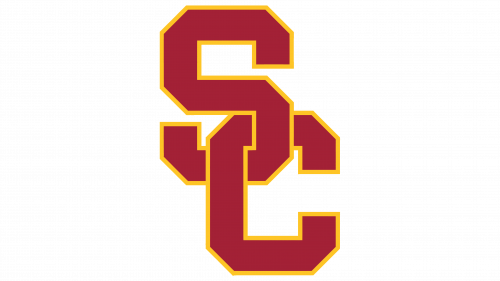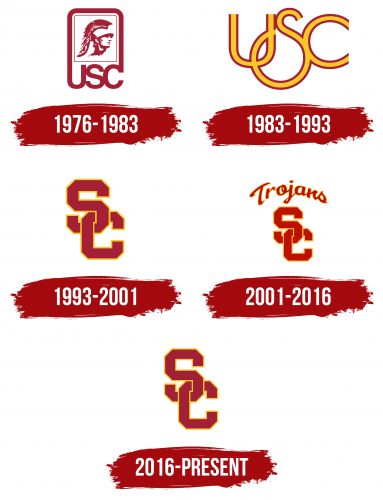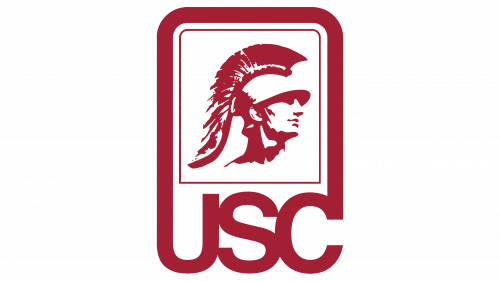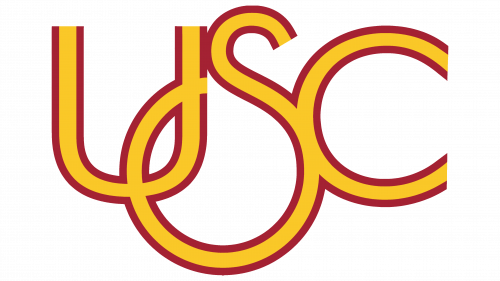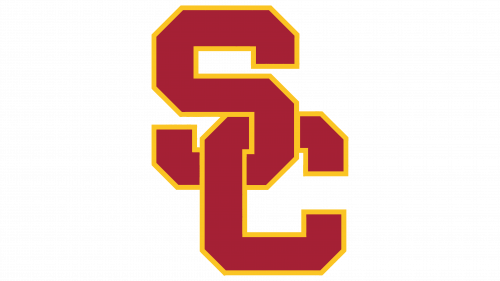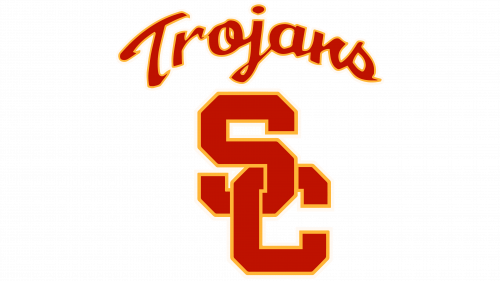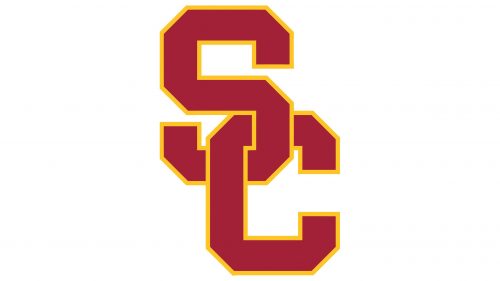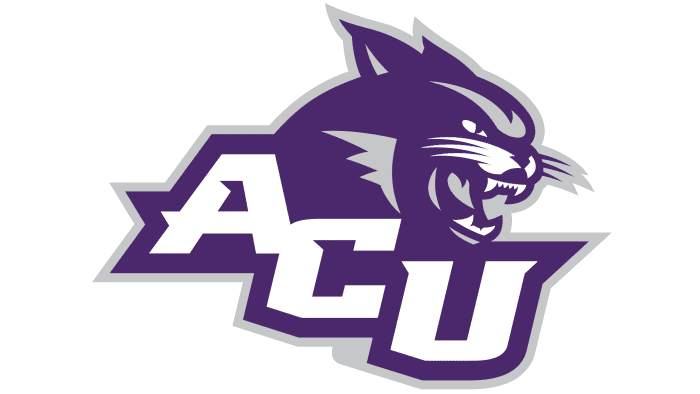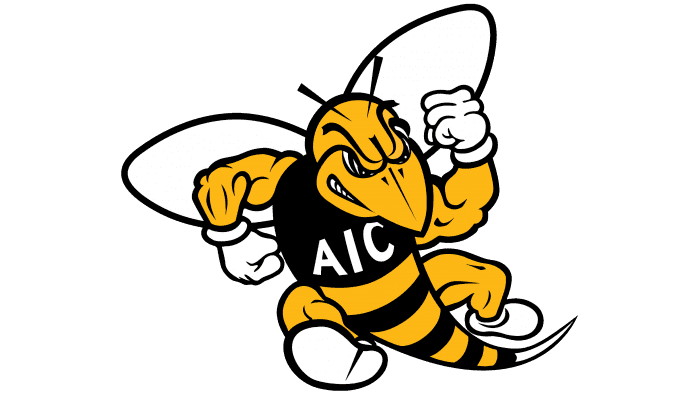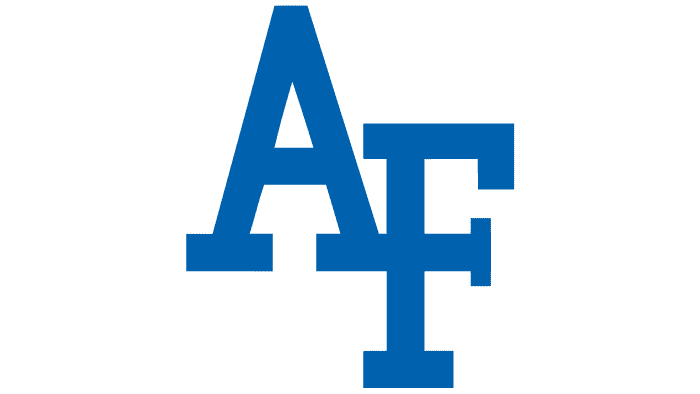The USC Trojans logo symbolizes resilience, strength, and confidence in victory. Every element of the logo highlights the continuous development of athletes on their path to success. The University of Southern California sports teams have been regarded as some of the toughest competitors for many years. Facing them offers many a chance for recognition, but more likely, not victory.
Countless successful battles have turned the USC Trojans into legendary athletes. Being a part of this team means belonging to a league of true professionals, confirming their title as “one of the strongest.” The modern identity vividly demonstrates the strength of metal. Like links in a reliable chain, the letters interlock, signaling to everyone around that the team is united and unbeatable.
This is only part of the symbolism of the modern logo, as it reflects the team’s strengths in a multifaceted way. The team spirit, resilience, and absolute unity are conveyed. The original color scheme was chosen to make the logo elegant and regal.
USC Trojans: Brand overview
The University of Southern California (USC) was established in 1888, marking the beginning of the Trojans’ history. The athletic program started to take shape almost immediately after the university was founded, even though the sports teams did not officially adopt the name “Trojans” until 1912. USC’s inaugural football squad was founded in 1889, and it faced a local sports league in its first game. The illustrious sporting history of the university began at this precise moment.
The Los Angeles Times sports editor Owen Bird originally used the term “Trojans” to refer to athletes in 1912. When the term caught on, all collegiate sports teams adopted it as their official name. The decision to adopt “Trojans” as a mascot was motivated by the tenacity and fighting spirit attributed to the Trojan people of antiquity.
The athletics programs saw substantial expansion in the 1920s. The Los Angeles Memorial Coliseum, constructed in 1923, is now home to the football team. With more than 90,000 seats, this stadium continues to be one of the most recognizable sports arenas in the country.
The football team’s first major victories occurred in the 1930s. Under head coach Howard Jones, the team earned its first national championship in 1931. This accomplishment was replicated in 1932, setting the stage for the eventual football dynasty at the institution.
Mike Garrett and O. J. Simpson were two great running backs who made the team famous as “Tailback U” in the 1960s. In 1965, Garrett took home the esteemed Heisman Trophy, and in 1968, Simpson did the same.
The 1970s were a golden age for the football program. In 1972 and 1974, the squad won national championships under John McKay’s great coaching. McKay started an outstanding tradition that is still followed today.
The athletic program maintained its position as one of the top programs in the nation during the 1980s and 1990s. The football team routinely made it to major bowl games, and other sports teams had great success.
Another era of football dominance occurred in the 2000s. In 2003 and 2004, the team won national titles under head coach Pete Carroll. During this time, quarterback Matt Leinart and running back Reggie Bush won the Heisman Trophy.
One of the best football programs in the nation is still at the university. The squad advanced to the national championship game in 2005, but Texas defeated them in one of the most exciting college football games ever. This year’s Heisman Trophy winner, Reggie Bush, had his honor later withdrawn because of NCAA rule infractions.
Pete Carroll led the football team to consistent success from 2006 to 2009. The squad participated in esteemed bowl games and routinely won the Pac-10 conference.
In 2010, the NCAA sanctioned the institution for Reggie Bush-related infractions. This resulted in decreased scholarships and a two-year exclusion from bowl games. The squad maintained its competitive performance despite this.
One of college football’s most important games, the Rose Bowl, was won in 2016. With the help of quarterback Sam Darnold, the squad entertainingly defeated Penn State.
The university also has notable basketball success. The men’s team had one of the best seasons in program history in 2007 when they made it to the Sweet Sixteen of the NCAA tournament. In 2021, they advanced to the Elite Eight.
The sports department maintained its outstanding history. Many athletes successfully competed at the Olympic Games, and the squad consistently finished high in national championships.
The football team had a successful 2017 season. Led by quarterback Sam Darnold, the squad defeated Stanford in the title game to win the Pac-12 conference. The team’s performance earned them a spot in the Cotton Bowl, where Ohio State defeated them.
For the football program, 2018 and 2019 were a time of rebuilding. The head coach was replaced due to the team’s inconsistent performance. Clay Helton had been with the team since 2015 and was under growing strain.
Despite having a truncated season in 2020, the institution advanced to the Pac-12 Conference Final and defeated Oregon.
Major alterations were made to the football program in 2021. Clay Helton was let go following the season’s underwhelming start. At the end of the season, the institution revealed that Lincoln Riley, one of the nation’s most successful young coaches, would be taking over as head coach, and the football community became excited.
Success in other sports was equally prominent. In 2021, the men’s basketball team had one of its best performances in program history, making it to the Elite Eight of the NCAA tournament. The women’s basketball team, which frequently competes in the NCAA tournament, likewise performs well.
The athletic department maintained its outstanding history. Many athletes participated successfully in international contests, and the squad consistently ranked highly in national championships.
The institution consistently won conference titles and competed for national championships in water sports, particularly swimming and water polo, where they maintained high positions.
Throughout their existence, the Trojans have excelled in several sports. Along with many other sports, the university is renowned for its robust basketball, track and field, and swimming departments.
Upholding the standards of excellence set more than a century ago, the Trojans remain among American collegiate athletics’ most prosperous and well-known athletic departments.
Meaning and History
The University of Southern California athletic teams are considered the most successful in the NCAA Division I. They have won over 300 Olympic medals, most of which are gold and 130 national championships. The program covers men’s and women’s sports, from football and baseball to water polo and tennis. The branch is named Trojans after the ancient warriors. Rumor has it that the Los Angeles Times sports columnist coined the nickname when describing the stamina and courage of the athletes. It is reflected in the symbols of the teams.
What is USC Trojans?
This athletic team represents the University of Southern California in Los Angeles, California. The university, a member of the Pac-12 conference, is known for its successful multi-sport program and rich athletic heritage. The Trojans soccer program is well-known and has produced several NFL players and Heisman Trophy winners. In addition, other sports such as volleyball, water polo, track and field, and swimming are well-established at the university. The university’s mascot, the Trojan Warrior, and the Cardinal Gold colors are well-known icons in college athletics. One of the most famous college athletic facilities is the Los Angeles Memorial Coliseum, one of the University’s athletic complexes.
1976 – 1983
The original logo was quite simple but an associative and powerful symbol. Against a white background, a vividly depicted Trojan, a fearless Greek warrior whose gaze and attire indicated his excellent prospects for victory. Three capital letters were placed below the warrior’s portrait, signifying who had unbeatable chances for triumph.
Although the logo seemed simple at first glance, its creators added depth. The warrior was placed within a frame symbolizing a shield, representing absolute security and eliminating the possibility of competitors’ superiority. A second element was added to increase the significance and presentability—another geometric shape. If the first frame was a square, the second element was part of the first and last letters, reinforcing the message of the team’s invincibility.
Capital letters were used to enhance importance and served as a protective element. The red color increased the logo’s brightness, creating an original and expressive contrast against the white background.
1983 – 1993
The image of the Trojan, a Greek warrior, could not remain on the logo forever. The identity required more individuality and precise identification. It was unacceptable for the symbol of 21 university sports teams to be ambiguous. Therefore, the warrior’s portrait permanently disappeared from the logo. The new logo became more concise, accurately reflecting the sports theme. Even those not connected with sports can easily understand that the logo connects to the Olympic Games. The interconnected rings predetermine this association, but their presentation is somewhat different, making the logo unique.
Against a white background, three capital letters are beautifully positioned. They are large, rounded, and enclosed in a frame. The central part of the letters is filled with a rich orange color, and the frame is red and wide. The main emphasis is on the “S” in the logo’s center. The two other letters are in the background. The logo’s individuality is highlighted by the elongated lower part of the letter “S,” reminiscent of one of the Olympic rings.
1993 – 2001
Time demanded a unique logo. The creators set a goal to design an original symbol. As a result, all roundness disappeared. Now, the letters were arranged vertically instead of horizontally. The total number of letters was reduced by one, leaving only “S” and “C.” They existed as a single, inseparable unit. The logo reflected the Trojans’ excellent performance, arduous path to victory, collective effort, and hard work of each participant. The identity emphasizes that only together can rivals be surpassed, and only by uniting can love and respect from the audience be earned.
2001 – 2016
If you study each element of the new identity, you can see that a significant part has been preserved from previous years. The lettering has not lost its scale or changed the overall color scheme. Only a few additions managed to transform the logo. The size of the letters “S” and “C” was altered, and their placement was slightly lowered. They, as before, symbolized teamwork and the unification of players for better results. At the top of the logo, as if handwritten, the word “Trojans” now shone. It reminded of victories, achievements, and the most important battles in the world of sports competitions. The main red color and the orange stroke used for the frame of each letter added originality.
2016 – today
The modern logo precisely replicates its predecessor, created in 1993. This return to the past was not chosen by chance, as that period was one of the most successful in the team’s history. However, this was not the only reason for returning to the roots of the identity. In today’s world, simplicity and detail have come to the forefront. As a result, the use of images and text has lost its relevance. A sports team’s logo should emphasize unity and the challenging path to victory.
The letters of the modern logo are arranged vertically, symbolizing a strong connection and reliability. The lower part of the “S” is firmly connected to the upper element of the “C,” forming a single structure. Both letters are in red with a slight gradient and outlined in a bright orange border. The logo’s background remains white, creating a vivid and contrasting image.
